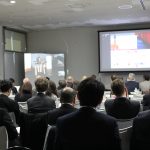Every finished product went through a series of tests before it became ready for the public, every software that was ever developed had to go through the same process too. Any product we use in our day-to-day activities had a prototype first with the purpose of finding out how this product works in the real world and if there are any changes needed to make it function better. Take a look below at the in-depth reason behind rapid prototyping and why it’s beneficial.
How the Process Starts
Every designer or developer in any field needs to think of how his or her product will serve the public and what the reason behind this product is. The designer/developer starts to draw out a blueprint or sketch of his or her design, or on a design software on their computer. Then after a series of examples made with different in-depth details and designs, they would finally choose one to their liking. After that, they would start getting ready for prototyping this design, but it doesn’t have to be 100% exactly the same, just something that covers the different aspects of the product so there are more than one available for testing. After some trial and error testing and going back and forth between design and raw prototyping, at some point the designer would need a prototype that is an accurate replica of the end product he’s working on. Finally, the rapid prototyping can begin from there, using any of the different techniques.
What Is Rapid Prototyping?
It’s basically a phase in the physical or digital testing of products to see how they work and what they look like. But some people might not be able to do it alone or have the means to make it happen, so they might look into deals with other companies that can. According to the people at https://prototechasia.com/en/silicone-molding, they believe that one should support the developer’s innovation and the new generation of their product. You see, there are a series of different techniques that designers and developers use to formulate and put together a 3D scale model of the physical product or software. It makes a huge difference in these early phases of the product because it gives the developers and designers complete freedom to alter and fabricate anything to test it out. It’s a way for them to have complete control, exploring every detail quickly and more efficiently. The modeling technique of rapid prototyping helps speed things up in the early development process through different ways like three-dimensional printing, stereolithography, selective laser sintering, additive manufacturing, and software applications, all of which is explained better below:
Types Of Rapid Prototyping:

- Stereolithography: This is one of the most common types of rapid prototyping processes. Basically, it’s a UV laser that’s being controlled by a computer that draws the image of the object on the surface of liquid plastic. The laser goes back and forth passing on the surface, hitting the liquid plastic and thereby hardening it. At the completion of each pass, the object would be lowered so that the UV laser could go through its next pass path. This process would continue until the end result is a carved out 3D physical model of the product.
- Selective Laser Sintering: This method also works with a high powered laser. As the laser starts to move over the surface of thermoplastic powders, it fuses cross-sections of the material layer by layer. When one layer is completed, the process is repeated by lowering the powdered bed and then adding a new layer of material. Which in the end would give the developer what he or she wants to start testing it out.
- Additive Manufacturing: This type is more commonly known as Fused Deposition Modeling. The process starts by having a heated melted thread of plastic pass onto a laid down surface that is commonly known as a build-platform, then it begins passing through in a layer by layer fashion by using an extrusion nozzle. This nozzle is controlled by a computer-aided manufacturing software and a mechanical device that holds the final image of the product. The moment it hits the build-platform, the liquid solidifies and the platform lowers where the next layer of liquid is laid on it. This process continues until the prototype product is complete and ready for testing.
- Software Rapid Application Development: This method is also known as Rapid application building, the general term is used to refer to the adaptive software development approaches. This type is well-suited for developing software that is mostly driven by user interface requirements. The graphical user interface builders are often called rapid application development tools. These tools provide valuable information to the designer in regards to the feasibility of the design that he or she is working on. It can prevent the team from pursuing solutions that turn out to be too complex or time-consuming to implement into something physical. Thus, it allows finding problems and setbacks early in the life-cycle; the earlier a problem can be detected, the cheaper it is to address and fix.
The Advantages Of Rapid Prototyping
There are so many good things that developers and designers could benefit from rapid prototyping, take a look below at some useful things about it:
-
Saves Time:

As the old expression goes, “Time is money.” It’s really important in anything that you save time while doing it. When you get rid of the time needed to produce molds, patterns, and special tools that are needed for conventional modeling, this leads to time reduction between the initial design and the analysis. An accurate model is quickly available to the developers and designers for testing its form, usability, performance, and features. It is a highly automated process that enables creators to quickly modify and change products in line with the feedback they get. The time savings can help organizations gain a decent competitive advantage by bringing new products to the market quickly and ahead of their competitors.
-
Saves a lot of Money:
When you reduce costs, everyone is happy and satisfied. It helps significantly in reducing the costs of product development and manufacturing. You no longer need to develop special tools for each new product that you have because it uses the same CAD and printing equipment each time. The automated process also reduces the costs of staff and the costs of waste too. When the technique only adds modeling material where it’s needed, that’s a lot of material available for you for different and additional tests. The conventional and traditional prototyping techniques create waste through cut-off material or chippings as the tools create the finished model, but rapid prototyping does not. So that’s money saved as well.
-
Making Changes Quickly:
When the designers and developers have a physical model on hand at their disposal, it is possible to modify and implement changes instantly merely by getting the feedback from the testers. Before finalizing the design of the product, there are several steps required. And with each step in the process, the design improves further; therefore building confidence for both the designer and developer as well as the end consumer. This also helps in identifying the actual needs of the market, making it possible to come up with useful and competitive products with a better acceptance rate from the people.
-
Complete Freedom and Flexibility:
One of the best benefits of rapid prototyping is the ability to develop and modify customized products according to the individual’s requirement. It doesn’t need complex and hard-to-use tools or processes to implement design changes in the product. A small change in the CAD model or a tweak in the design and the entire process would remain the same. It can be done at any time depending on the feedback that was given because this is all a testing phase it won’t hinder the end product at all. There’s no fear of going over the budget either because the developers and designers have full control over the changes that are being done with no further costs needed. Also, the manufacturers can be pleased because, this way, it will be highly advantageous to them as it offers a connected experience for the customer with the product that they purchased.
-
Visualizing To the Higher-Ups
The idea that you can create a realistic three-dimensional scale model helps designers in presenting the new product concepts to business owners, CEOs, clients, stakeholders, board members, or investors who need to understand and approve the development program and to continue to fund it. Designers can also gain feedback from potential customers and clients that way, feedback that is based on physical products. Rather than concepts or stories and ideas, this allows them to incorporate physical and realistic data in the later stages of product development. Thus, making the end product much better.
-
Gives Innovative and Creative Opportunities
There won’t be any more stale moments and boring ideas. Rapid prototyping opens up new doors and opportunities for innovation by cutting out the restrictions of traditional and conventional prototyping. The old ways would need you to start the production of prototype tooling and physical components that would cost a lot of money and waste precious time. Innovators and designers can create models incorporating complex shapes and surfaces that would be difficult or near impossible to reproduce by the old methods of prototyping.
-
Understanding The Product Better:
When you understand what you’re creating thoroughly, it would lead to better functionality and overall performance of the end product. By allowing creators the chance to realize their concepts beyond virtual visualization, this makes them understand the look and feel of the design, rather than simply assuming through a computer-aided design model. This also helps designers to move forward with their ideas and implement them in the image they see fit before the finalization process. It also provides a proof of concept for the end client, possibly even creating a need that the clients actually never thought of, leading to more sales and profitability in the future.
-
Lowering The Overall Risk
Everything ever created had its risks: the risk of failure, risk of a community backlash, risk of lawsuits, and many others. At the end of the day, it can all be somewhat avoided and handled before the products even reach the shelves. When you have a detailed physical analysis of the early stages in the development program, rapid prototyping can reduce the risk of costly and critical errors. The development team can identify the design faults or usability problems and make any modifications quickly before it causes any more damage. The process provides a precise model for production tooling, thus reducing the risk of later problems or setbacks that may happen.
The Beauty Of It
Rapid prototyping allows people to bring their innovative ideas to life in a very accurate, beautiful, and imaginative way to suit a number of purposes. It is a high-end tool that’s being used for pre-operative planning, concept modeling, diagnostics, and detecting flaws in the early design stages. It’s a technology that has already spread into almost every aspect of our lives. From engineering, education, art, architecture, medicine, and manufacturing. It has become a crucial part of any product’s life-cycle in the early production or manufacturing phases. Testing it all out, using one or more of the different techniques can really make a difference in the overall image and purpose of the product. The great thing about it is that it’s all tests and not the real thing given to the public yet, nothing wrong can come from alpha testing and beta testing your products or software to be better.











